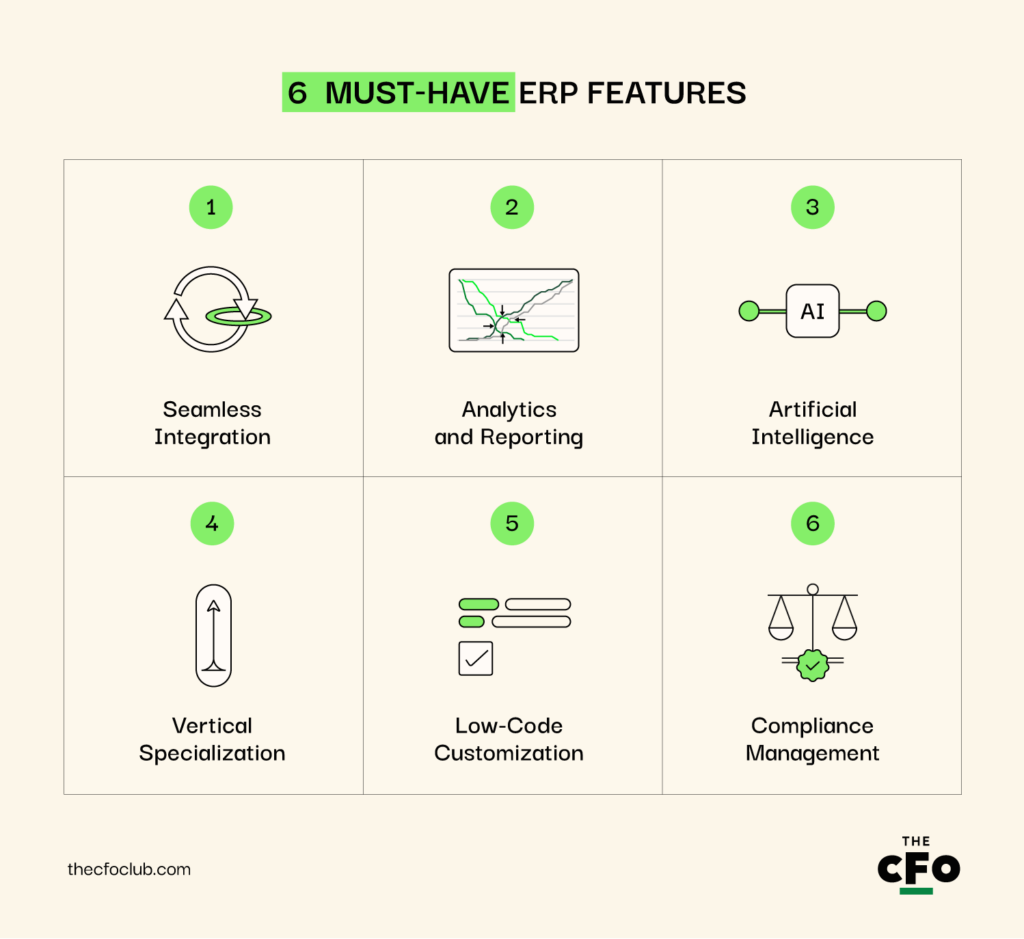In the last 5 years, there has been a major shift towards cloud-based ERP software with features that old-school systems couldn't have conceived of.
For instance, modern ERPs are increasingly incorporating AI and ML capabilities to enable intelligent automation, predictive analytics, chatbots, and personalized user experiences. Sound cool? It is.
Here are the key features you want to be looking out for when selecting an ERP system.
What are ERP Features?
ERP features are the specific capabilities and functionalities included in an ERP software suite, such as real-time analytics, mobile accessibility, and AI-powered automation.
They are different from ERP functions (AKA modules or components), which are broader applications for areas like order management, customer relationship management (CRM), business intelligence, accounting, and human resource management (HRM).
When in the market for ERP software, you need to prioritize features that align the closest with your business processes. Here are some common examples:

1. Seamless Integration
Integrations enable streamlined data flow. They also enhance visibility and improve operational efficiency across the enterprise. By connecting your cloud ERP with the broader business application ecosystem, you can break down data silos, automate processes, and unlock new workflows you hadn’t even thought of.
Look for a solution that supports an open architecture, has a bevy of direct pre-built connectors, offers integrations with tools like Zapier and Make, and provides access to its own API.
API Access
Application programming interfaces (APIs) are the backbone of seamless ERP integrations. They enable real-time data exchange, ensuring that information is always up-to-date and accurate across all connected systems.
Pre-Built Connectors
ERP vendors often provide pre-built connectors and integration templates for popular business applications like Salesforce, Workday, and Tableau. These integrations can cut down the time it takes to connect the two platforms; usually with better data exchange outcomes.
Integration Platforms
For more complex integration scenarios, ERP vendors work with Integration Platform as a Service (iPaaS) solutions like Zapier, Make (Integromat), and Automate.io to facilitate a wider range of applications and services.
2. Analytics And Reporting
Real-time analytics allow businesses to analyze data as it’s generated, providing immediate visibility into key performance indicators (KPIs), trends, anomalies, and more. By analyzing data in real-time, organizations can quickly identify and respond to changing market conditions, customer behavior, and operational issues.
ERP systems integrate data from various business functions, such as finance, sales, inventory, and production, into a centralized database. Advanced analytics technologies, such as in-memory databases, data streaming, and complex event processing (CEP), enable software platforms to analyze this data instantly to provide relevant insights for data-driven decisions.
Financial Reports
Real-time financial reports, such as income statements, balance sheets, and cash flow statements, provide a comprehensive view of an organization's financial health. These reports help businesses track expenses and analyze profitability to make informed financial decisions.
Sales Reports
Sales reports offer insights into sales performance, revenue, customer acquisition, and sales team productivity. Businesses can use these reports to identify sales opportunities, improve customer relationships, and optimize sales strategies.
Inventory Reports
Inventory data provides information on stock levels, turnover rates, and stock movement. These reports help businesses optimize their supply chain management, minimize stockouts and overstocking, and streamline inventory operations.
Production Reports
Production reports track and analyze production processes, including volumes, cycle times, quality metrics, and resource utilization. Businesses can use these reports to monitor production efficiency, identify bottlenecks, and improve overall operational performance.
Customer Reports
Real-time customer reports offer insights into customer behavior, satisfaction, loyalty, and preferences. By analyzing these reports, businesses can personalize marketing efforts, enhance customer experience, and drive customer retention.
3. Artificial Intelligence
While AI in ERP has been a bit over-hyped, it can deliver real value when applied to the right use cases, such as streamlining tasks like invoice matching and demand forecasting.
Chatbots use natural language processing (NLP) to simplify data access. However, if you want bigger results, I recommend tying AI features to practical business outcomes in an ERP system.
But, while AI offers tremendous potential for ERP systems, it's important to be cautious of “AI washing”. Owing to the recent uptick in the demand for AI, ERP vendors sometimes exaggerate their AI-powered feature sets and the value they bring to businesses. To make sure you don’t fall victim to this trend, be sure to:
- Request concrete evidence and demonstrations of AI capabilities
- Look for specific use cases and measurable benefits
- Involve your IT team in the evaluation process
- Prioritize solving business problems over chasing the AI hype
Intelligent Automation
One of the key benefits of ERP using AI is the ability to automate routine tasks and processes. By using machine learning algorithms, ERP systems can learn from historical data and user behavior to automate tasks such as data entry, project management, invoice processing, and inventory management.
This not only saves time and reduces errors but also allows employees to focus on more strategic and value-added activities.
Predictive Analytics
AI-powered predictive analytics enables ERP systems to analyze vast amounts of data and provide accurate forecasts and data analysis. By identifying patterns and trends in historical data, AI algorithms can predict future outcomes like demand fluctuations, resource requirements, and potential risks.
Personalized User Experiences
AI can also enhance the user experience within ERP systems by providing personalized recommendations, intelligent search capabilities, and conversational interfaces.
By understanding user preferences and behavior, AI-powered ERP systems can tailor the user interface, provide context-specific suggestions, and enable natural language interactions—making the system more intuitive and user-friendly.
For example, if you work in retail or ecommerce, an ERP software for the apparel industry with these features can help you harness valuable customer data and tailor your product to specific need cases.
4. Vertical Specialization
Vertical specialization is a key trend in modern ERP systems, where vendors develop industry-specific solutions tailored to the unique needs and processes of particular sectors. By focusing on the nuances of a specific industry (like nonprofit organizations or ecommerce), ERP solutions can deliver more targeted functionality, faster implementation, and greater value compared to generic software.
Vertical ERP solutions are designed with built-in features, workflows, and best practices that align with the specific requirements of a given industry.
For example:
- Manufacturing ERP includes capabilities for production lifecycle planning, quality control, shop floor allocation, and asset management.
- Retail ERP offers features for point-of-sale, merchandise management, omnichannel commerce, tracking inventory levels, and customer information management.
- Healthcare ERP supports patient management, medical billing, and compliance with regulations like HIPAA.
By providing industry-specific functionality out-of-the-box, vendors can reduce the need for extensive customization to support more complex use cases.
Faster Implementation
With pre-configured industry-specific features and templates, ERP implementation for vertical platforms can be quicker than generic systems that require significant customization. With a faster onboarding process and the proper ERP training programs, the time to value is also much shorter.
Continuous Innovation
Vertical enterprise resource planning systems are constantly evolving their solutions to keep pace with industry changes and emerging technologies. They invest in research and development to incorporate new capabilities that help their clients adapt to shifts in market dynamics, regulatory requirements, and customer expectations.
5. Low-Code Customization
By using visual interfaces and pre-built components, ERP platforms can democratize customization by reducing the need to involve the IT department for every minor change. You can modify workflows, forms, reports, and much more without having to deal with complex programming languages.
Visual Development Environment
Low-code ERP platforms provide a user-friendly visual development environment that allows users to create and modify applications using intuitive drag-and-drop functionality. With a library of pre-built components, modules, and templates that users can easily configure, building custom applications to support industry-specific use cases becomes much easier.
Rapid Prototyping
Low-code customization enables rapid prototyping and iteration of ERP applications. Business users can quickly create functional prototypes, gather feedback, and make adjustments in real-time, ensuring that the final product aligns closely with requirements and stakeholder expectations.
Better Integration Support
Low-code ERP platforms are designed to seamlessly integrate with existing systems and data sources, allowing businesses to extend and customize their ERP capabilities without disrupting their IT ecosystem. Low-code solutions are inherently scalable, enabling organizations to easily adapt and grow their ERP system as their IT needs change.
For example, if you work at in the oil and gas industry, your business may need higher customization and integration requirements to make sure all your information is correctly stored and accounted for.
6. Compliance Management
Regulatory compliance is a critical aspect of modern business operations. ERP software provides a centralized platform for managing and tracking compliance-related data, processes, and reporting. By using an ERP software, companies can derisk their compliance efforts when handling financial data, payment details, purchase orders, and contact.
Data Management
One of the key ways ERP systems support regulatory compliance is through centralized data management. By consolidating data from various departments and functions into a unified dashboard or database, ERP software ensures data consistency, accuracy, and accessibility.
For example, say you work for a government agency managing public health data. An ERP system can centralize inputs from departments like epidemiology, logistics, and communications into one consistent platform.
This unified view reduces data silos and ensures that all regulatory reports submitted to oversight bodies are based on accurate, up-to-date, and verifiable information, which is vital in maintaining compliance and public trust.
Audit Trails
ERP systems provide built-in audit trail functionality, recording all changes made to data, transactions, and system configurations. This audit trail serves as a valuable record for internal reviews and external audits, helping organizations prove their compliance efforts.
Automated Compliance
ERP systems can automate many compliance-related processes, reducing the risk of human error and ensuring consistent adherence to regulatory requirements.
For example, they can automatically generate compliance reports, trigger alerts for potential compliance issues, and enforce approval workflows for sensitive transactions. This is extremely beneficial in highly regulated sectors, like healthcare and chemical-based industries.
Best ERP Systems on the Market
Now that you know what features you’re looking for, it’s time to go shopping. These are the best ERP systems currently on the market, as reviewed by my team:
- 8. NetSuite ERP
- 10. Total ETO
Subscribe For More ERP Insights
The features of ERP solutions can get increasingly complex and nuanced depending on your industry, applications, and use case. There’s no one-size-fits-all advice on which features you should prioritize from ERP vendors. However, if you feel lost, consider working with professional consultants who can advise you on this type of thing.
But if you prefer to do your own research first, subscribe to our free newsletter for expert advice, guides, and insights on ERP solutions from finance leaders shaping the tech industry.



